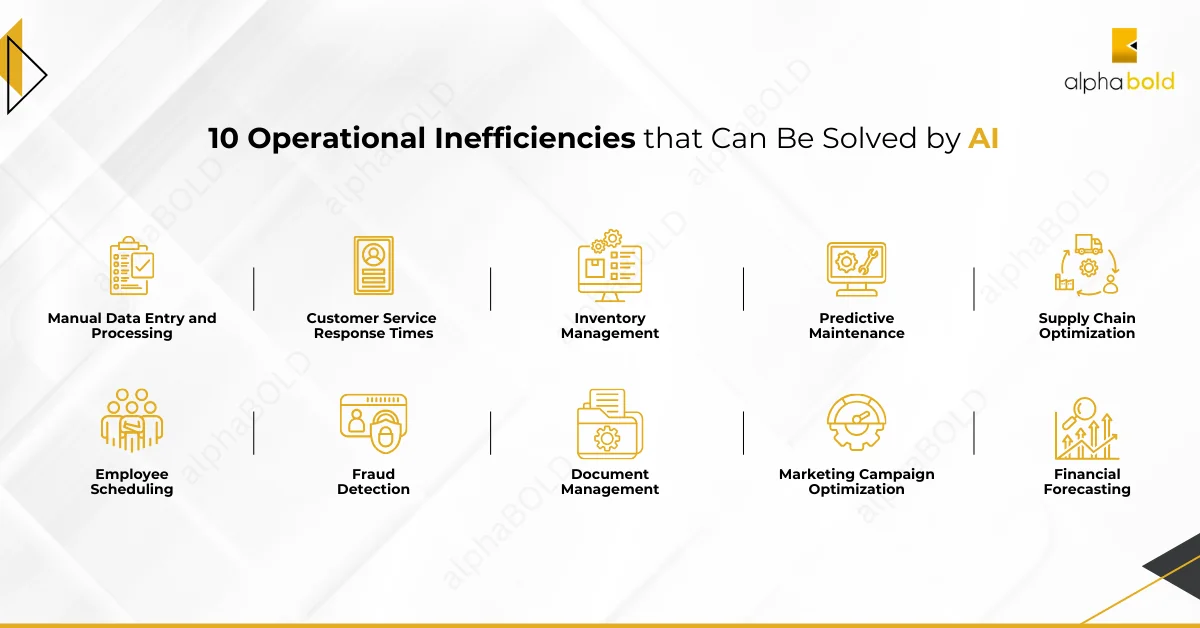Introduction
In this blog post, we will explore ten common operational inefficiencies that can be effectively addressed by AI. We will answer frequently asked questions such as “What can you solve with AI?”, “What can I solve with AI?”, “What processes can be fixed with AI?”, and “What can AI do?”. Join us as we delve into the specific ways AI can transform your business operations and help you stay ahead in a competitive landscape.
Operational efficiency within a business is crucial for maintaining a competitive edge and driving growth. Artificial Intelligence (AI) is emerging as a transformative force, capable of revolutionizing how businesses operate by automating processes, enhancing decision-making, and uncovering valuable insights. From streamlining routine tasks to predicting future trends, AI offers innovative solutions that can address a wide range of operational inefficiencies.
AI’s relevance in solving these inefficiencies cannot be overstated. It not only helps businesses save time and reduce costs but also improves accuracy and productivity across various functions. By leveraging AI technologies, companies can optimize their operations, enhance customer experiences, and ultimately achieve better outcomes.

1. Manual Data Entry and Processing
Manual data entry and processing are not only time-consuming but also highly prone to errors. Employees often spend countless hours inputting data from various sources into systems, which can lead to fatigue and mistakes. These errors can result in significant operational inefficiencies, from inaccurate records and reports to delays in decision-making and increased operational costs. Additionally, the average cost of a data breach caused by human error is $3.33 million, according to the IBM Security Cost of a Data Breach Report 2023. The repetitive nature of manual data entry also means that valuable human resources are diverted from more strategic and value-adding activities.
AI-driven data extraction and Optical Character Recognition (OCR) tools offer a powerful solution to the inefficiencies of manual data entry and processing. These technologies can automatically capture data from documents, emails, forms, and other sources, accurately transforming it into structured digital formats. AI algorithms can recognize and extract relevant information with high precision, significantly reducing the likelihood of errors.
- Automation: AI tools can automate the entire data entry process, from capturing data to inputting it into your systems. This not only speeds up operations but also ensures consistency and accuracy.
- Accuracy: AI algorithms improve over time through machine learning, continuously enhancing their ability to recognize and process data correctly.
- Resource Allocation: By automating repetitive tasks, businesses can reallocate human resources to more strategic roles that require creativity and critical thinking.
By implementing AI-driven data extraction and OCR tools, businesses can eliminate the inefficiencies of manual data entry, leading to faster, more accurate, and cost-effective operations. Operational inefficiencies that can be solved by AI are numerous, making these technologies indispensable for modern businesses.
2. Customer Service Response Times
Slow customer service response times can significantly impact customer satisfaction and loyalty. In today’s digital age, customers expect quick and efficient support when they encounter issues or have questions. Delayed responses can lead to frustration, negative reviews, and ultimately, a loss of business. According to a study by HubSpot, 90% of customers rate an “immediate” response as important or very important when they have a customer service question. This underscores the need for businesses to find efficient ways to handle customer inquiries promptly and address operational inefficiencies that can be solved by AI.
AI chatbots and virtual assistants offer an effective solution to the problem of slow customer service response times. These AI-driven tools can handle a wide range of customer inquiries instantly, providing quick and accurate responses around the clock. Here’s how they can transform customer service:
- 24/7 Availability: AI chatbots can operate continuously without breaks, ensuring that customers can get help at any time, even outside of regular business hours.
- Instant Responses: AI-powered chatbots can provide immediate answers to frequently asked questions, significantly reducing wait times.
- Scalability: AI solutions can handle multiple inquiries simultaneously, which is particularly beneficial during peak times or when there is a sudden surge in customer queries.
- Personalization: Advanced AI systems can personalize interactions based on customer data, offering tailored responses that enhance the customer experience.
For instance, businesses like Bank of America have implemented AI-driven virtual assistants like Erica, which help customers with a variety of banking needs, from checking account balances to making payments. This not only improves response times but also enhances overall customer satisfaction .
By integrating AI chatbots and virtual assistants into their customer service operations, businesses can significantly improve response times, leading to higher customer satisfaction and loyalty while addressing operational inefficiencies that can be solved by AI.
Enhance your Customer Service with AI
Contact AlphaBOLD to learn how AI chatbots can provide instant responses and improve customer satisfaction.
Request a Consultation3. Inventory Management
Poor inventory management can lead to a host of problems for businesses, including stockouts, overstocking, increased holding costs, and lost sales opportunities. Stockouts can frustrate customers and push them towards competitors, while overstocking ties up capital and storage space that could be used more effectively elsewhere. Moreover, manual inventory tracking methods are often inaccurate and time-consuming, leading to inefficiencies that can disrupt the entire supply chain. These are typical operational inefficiencies that can be solved by AI.
AI offers powerful solutions for optimizing inventory management through predictive analytics and automation. By leveraging historical data, market trends, and real-time information, AI can accurately forecast demand and ensure optimal stock levels. Here’s how AI can transform inventory management:
- Demand Forecasting: AI algorithms analyze past sales data, seasonality, and market trends to predict future demand with high accuracy. This helps businesses maintain the right inventory levels to meet customer needs without overstocking.
- Automated Reordering: AI systems can automatically trigger reorders when stock levels fall below a certain threshold, ensuring that inventory is replenished just in time to avoid stockouts.
- Inventory Optimization: AI can identify patterns and correlations that human analysis might miss, such as which products sell together or how promotions impact sales, helping to optimize inventory placement and reduce holding costs.
- Real-Time Monitoring: AI-powered tools provide real-time visibility into inventory levels across multiple locations, allowing businesses to make informed decisions and quickly respond to changes in demand.
For example, companies like Walmart use AI-driven inventory management systems to keep their shelves stocked efficiently. These systems analyze vast amounts of data to predict customer demand accurately and automate inventory replenishment, resulting in improved efficiency and customer satisfaction .
By implementing AI solutions for inventory management, businesses can address the inefficiencies caused by poor inventory practices, leading to more accurate demand forecasting, reduced costs, and better customer service, thus solving operational inefficiencies that can be solved by AI.
4. Predictive Maintenance
Unplanned equipment downtime can have severe repercussions for businesses, leading to costly repairs, production delays, and significant financial losses. When machinery breaks down unexpectedly, it disrupts the entire workflow, causing delays that can affect delivery schedules and customer satisfaction. The costs associated with unplanned downtime extend beyond repair expenses, encompassing lost productivity and potential overtime wages for workers tasked with fixing the issues. These disruptions are prime examples of operational inefficiencies that can be solved by AI.
AI-driven predictive maintenance offers a proactive approach to managing equipment health, reducing the likelihood of unexpected breakdowns and the associated costs. By leveraging advanced machine learning algorithms and real-time data analytics, AI can monitor equipment performance, identify patterns, and predict potential failures before they occur. Here’s how AI can revolutionize maintenance processes:
- Real-Time Monitoring: AI systems continuously monitor equipment through sensors that collect data on various parameters such as temperature, vibration, and pressure. This real-time data provides a comprehensive view of equipment health.
- Predictive Analytics: Machine learning models analyze historical and real-time data to identify patterns and trends that precede equipment failures. This allows for accurate predictions of when maintenance will be needed.
- Scheduled Maintenance: Instead of following a fixed maintenance schedule, AI enables condition-based maintenance. This ensures that maintenance activities are performed only when necessary, optimizing maintenance schedules and resources.
- Cost Savings: Predictive maintenance minimizes downtime, reduces repair costs, and extends the lifespan of equipment. This leads to significant cost savings and improved operational efficiency.
- Enhanced Safety: By preventing unexpected equipment failures, AI helps maintain a safer work environment, reducing the risk of accidents and injuries.
For instance, General Electric (GE) utilizes AI for predictive maintenance in their industrial equipment. Their AI-powered platform, Predix, analyzes data from machinery to predict failures and optimize maintenance schedules. This has helped GE and its clients significantly reduce downtime and maintenance costs .
By adopting AI-driven predictive maintenance, businesses can transform their maintenance operations from reactive to proactive, leading to improved equipment reliability, reduced costs, and enhanced productivity. This effectively resolves operational inefficiencies that can be solved by AI.
Prevent Unexpected Equipment Failures with AI.
Schedule a consultation with AlphaBOLD to learn how predictive maintenance can save you time and money.
Request a Consultation5. Supply Chain Optimization
Traditional supply chain management often struggles with inefficiencies such as inaccurate demand forecasting, poor logistics planning, and lack of real-time visibility. These issues can lead to increased operational costs, delayed deliveries, and reduced customer satisfaction. Managing a supply chain manually involves complex coordination between various stakeholders, making it difficult to respond quickly to changes in demand or supply disruptions. Consequently, businesses face challenges in maintaining optimal inventory levels, meeting delivery schedules, and minimizing transportation costs.
AI has the potential to revolutionize supply chain management by providing accurate demand forecasts, optimizing logistics, and enhancing overall supply chain visibility. Here’s how AI can address these inefficiencies:
- Demand Forecasting: AI algorithms can analyze historical sales data, market trends, and external factors (such as economic indicators and weather patterns) to predict future demand with high accuracy. This enables businesses to maintain optimal inventory levels, reducing both stockouts and overstock situations.
- Logistics Optimization: AI can optimize routing and scheduling for transportation, ensuring that goods are delivered in the most efficient and cost-effective manner. This includes real-time adjustments to routes based on traffic conditions, weather, and other variables.
- Inventory Management: By integrating AI with inventory management systems, businesses can achieve real-time visibility into inventory levels across different locations. AI can recommend actions to balance stock levels, move inventory between warehouses, and replenish stock just in time.
- Supplier Management: AI can help in evaluating supplier performance, predicting potential supply chain disruptions, and recommending alternative suppliers or sourcing strategies to mitigate risks.
- Operational Efficiency: AI-driven automation can streamline various supply chain processes, such as order processing, shipment tracking, and warehouse management, reducing manual effort and increasing accuracy.
For example, companies like DHL use AI to optimize their supply chain operations. DHL’s AI-powered supply chain solutions provide predictive analytics for demand forecasting, route optimization for logistics, and real-time visibility into the supply chain, resulting in improved efficiency and reduced costs .
By leveraging AI for supply chain optimization, businesses can enhance their ability to forecast demand, streamline logistics, and improve overall operational efficiency, leading to better customer satisfaction and reduced costs.
6. Employee Scheduling
Manual employee scheduling is a time-consuming and often inefficient process that can lead to overstaffing or understaffing. Managers must consider various factors such as employee availability, shift preferences, and business demands, making the task complex and prone to errors. Inaccurate schedules can result in higher labor costs, decreased employee satisfaction, and reduced productivity. Overstaffing leads to unnecessary labor expenses, while understaffing can strain employees, leading to burnout and compromised customer service. These issues represent significant operational inefficiencies that can be solved by AI.
AI-driven scheduling tools offer a sophisticated solution to the challenges of manual employee scheduling. By leveraging historical data, employee preferences, and real-time business needs, these tools can create optimized schedules that ensure adequate staffing levels while balancing workloads effectively. Here’s how AI can transform employee scheduling:
- Historical Data Analysis: AI algorithms analyze past scheduling patterns, employee performance, and business demand fluctuations to predict future staffing needs accurately.
- Employee Preferences: AI-driven tools can incorporate employee preferences and availability, creating schedules that improve employee satisfaction and reduce turnover.
- Real-Time Adjustments: AI can make real-time adjustments to schedules based on sudden changes in demand, employee absences, or unexpected events, ensuring that staffing levels remain optimal.
- Workload Balancing: AI scheduling systems can distribute shifts and tasks evenly among employees, preventing overburdening certain staff members and ensuring fair workloads.
- Compliance and Regulations: AI tools can ensure that schedules comply with labor laws and organizational policies, reducing the risk of legal issues and penalties.
For instance, Starbucks uses AI-driven scheduling to optimize staff shifts in its stores. By analyzing sales data, customer traffic patterns, and employee availability, Starbucks can create schedules that meet customer demand while keeping employees satisfied.
By implementing AI-driven scheduling tools, businesses can eliminate the inefficiencies of manual scheduling, reduce labor costs, improve employee satisfaction, and enhance overall productivity.
7. Fraud Detection
Detecting and preventing fraud manually is a complex and resource-intensive task that often fails to catch sophisticated fraudulent activities. Manual fraud detection relies heavily on predefined rules and human judgment, which can be easily circumvented by adept fraudsters. This approach is not only time-consuming but also prone to errors, resulting in significant financial losses, reputational damage, and regulatory penalties. The sheer volume of transactions that businesses process daily makes it nearly impossible for manual methods to keep up and identify fraudulent patterns effectively.
AI offers a robust solution to the challenges of fraud detection by analyzing transaction patterns and identifying anomalies in real-time. AI-powered fraud detection systems use machine learning algorithms to continuously learn from vast amounts of data, improving their accuracy and effectiveness over time. Here’s how AI can transform fraud detection:
- Pattern Recognition: AI algorithms can analyze historical transaction data to identify typical behavior patterns. By establishing a baseline of normal activity, AI systems can detect deviations that may indicate fraudulent activity.
- Real-Time Analysis: AI systems can monitor transactions as they occur, providing real-time fraud detection and prevention. This allows businesses to take immediate action to block suspicious transactions and mitigate potential losses.
- Anomaly Detection: Machine learning models excel at identifying anomalies that may go unnoticed by traditional rule-based systems. These models can detect subtle indicators of fraud, such as unusual transaction amounts, irregular transaction locations, and atypical account behaviors.
- Adaptability: AI-powered fraud detection systems can adapt to new fraud tactics by continuously learning from new data. This makes them more effective at identifying and preventing emerging types of fraud.
- Reduced False Positives: By using advanced analytics, AI can differentiate between genuine and fraudulent transactions more accurately, reducing the number of false positives and minimizing disruptions to legitimate customers.
For example, PayPal uses AI-driven fraud detection systems to monitor millions of transactions daily. Their AI models analyze transaction data in real-time to identify suspicious activities, significantly reducing fraud rates and protecting both the company and its customers.
By leveraging AI for fraud detection, businesses can enhance their ability to identify and prevent fraudulent activities, safeguarding their financial assets and maintaining customer trust.
8. Document Management
Managing and retrieving documents manually is a labor-intensive process that is prone to errors and inefficiencies. Businesses often deal with vast amounts of documents, including contracts, invoices, reports, and correspondence. Manually organizing, categorizing, and retrieving these documents can be time-consuming, leading to delays in accessing important information. Additionally, manual document handling increases the risk of misfiling, loss of documents, and inconsistencies in document management practices. These inefficiencies can hamper productivity, disrupt workflows, and negatively impact decision-making processes.
AI-powered document management systems offer a transformative solution to the challenges of manual document handling. By automating the organization, categorization, and retrieval of documents, AI can significantly enhance the efficiency and accuracy of document management processes. Here’s how AI can revolutionize document management:
- Automated Organization: AI algorithms can automatically organize documents based on their content, metadata, and context. This eliminates the need for manual sorting and filing, ensuring that documents are consistently and accurately organized.
- Intelligent Categorization: AI systems can categorize documents into relevant groups using natural language processing (NLP) and machine learning techniques. This enables quick and easy access to specific types of documents.
- Efficient Retrieval: AI-powered search capabilities allow users to retrieve documents quickly by using keywords, phrases, or contextual queries. This reduces the time spent searching for documents and ensures that information is readily accessible.
- Error Reduction: By automating document handling, AI minimizes the risk of human errors, such as misfiling or data entry mistakes. This improves the overall reliability of document management systems.
- Enhanced Security: AI can help enforce security protocols by monitoring document access and usage patterns, identifying potential security breaches, and ensuring compliance with data protection regulations.
For instance, IBM’s Watson Discovery uses AI to enhance document management by providing advanced search and retrieval capabilities. It can understand the context of documents, categorize them accurately, and enable users to find relevant information quickly and efficiently.
By implementing AI-powered document management systems, businesses can streamline their document handling processes, improve access to critical information, and enhance overall productivity.
Streamline your Document Management with AI.
Contact AlphaBOLD to discover how AI can automate document organization and retrieval.
Request a Consultation9. Marketing Campaign Optimization
Ineffective marketing campaigns can lead to wasted resources, poor return on investment (ROI), and missed opportunities to engage customers. Traditional marketing methods often rely on a one-size-fits-all approach, which fails to resonate with diverse customer segments. Additionally, manual analysis of campaign performance can be slow and prone to errors, making it difficult to adjust strategies in real-time. These inefficiencies can result in lower engagement rates, reduced customer acquisition, and ultimately, decreased revenue.
AI can optimize marketing campaigns by leveraging advanced analytics, machine learning, and automation to create personalized, data-driven marketing strategies. Here’s how AI can address marketing inefficiencies:
- Personalization: AI algorithms analyze customer data to create highly personalized marketing messages and offers. This ensures that each customer receives relevant content tailored to their preferences and behavior.
- Predictive Analytics: AI can predict customer behavior and trends by analyzing historical data, allowing marketers to anticipate customer needs and optimize campaigns accordingly.
- Automated Campaign Management: AI tools can automate various aspects of campaign management, including content creation, ad placement, and performance tracking. This reduces manual effort and increases efficiency.
- Real-Time Optimization: AI can continuously monitor campaign performance and make real-time adjustments to optimize ad spend, targeting, and messaging. This ensures that campaigns remain effective and responsive to changing market conditions.
- Enhanced ROI: By improving targeting accuracy and reducing wasted ad spend, AI-driven marketing campaigns can significantly enhance ROI and overall marketing effectiveness.
For example, Coca-Cola uses AI to analyze consumer data and predict future trends, enabling them to create targeted marketing campaigns that resonate with their audience. Their AI-powered marketing strategies have resulted in higher engagement rates and improved brand loyalty.
By leveraging AI for marketing campaign optimization, businesses can create more effective and efficient marketing strategies that drive better engagement, increase customer acquisition, and boost revenue, thereby addressing operational inefficiencies that can be solved by AI.
10. Financial Forecasting
Manual financial forecasting is a labor-intensive process that often results in inaccuracies and delays. Financial planners must manually collect and analyze data from various sources, which can be time-consuming and prone to errors. Inaccurate forecasts can lead to poor financial planning and decision-making, resulting in budget shortfalls, misallocated resources, and missed opportunities for growth. Additionally, the dynamic nature of markets means that manual forecasts can quickly become outdated, further complicating financial management.
AI-driven financial forecasting tools offer a powerful solution to the challenges of manual forecasting by providing accurate, real-time insights based on historical data and market trends. Here’s how AI can transform financial forecasting:
- Data Integration: AI tools can integrate data from multiple sources, including financial statements, market data, and economic indicators, to provide a comprehensive view of financial performance.
- Advanced Analytics: Machine learning algorithms analyze historical data to identify patterns and trends, enabling more accurate and reliable forecasts.
- Real-Time Updates: AI-driven systems continuously update forecasts in real-time as new data becomes available, ensuring that financial plans remain current and relevant.
- Scenario Analysis: AI can simulate various scenarios and their potential impact on financial outcomes, helping businesses to prepare for different market conditions and make informed decisions.
- Resource Allocation: Accurate forecasts enable better resource allocation, ensuring that funds are directed to the most promising projects and initiatives.
For instance, JPMorgan Chase uses AI-driven financial forecasting tools to enhance its financial planning and analysis. By leveraging AI, they can quickly analyze large volumes of data and generate precise forecasts, allowing them to make better strategic decisions and respond swiftly to market changes.
By adopting AI-driven financial forecasting tools, businesses can improve the accuracy and efficiency of their financial planning processes, leading to better decision-making and enhanced financial performance.
Conclusion
Artificial Intelligence is revolutionizing the way businesses operate by addressing a wide range of operational inefficiencies that can be solved by AI. From manual data entry and customer service response times to inventory management and financial forecasting, AI offers powerful solutions that enhance efficiency, accuracy, and overall performance.
By leveraging AI technologies, businesses can automate repetitive tasks, optimize resource allocation, and make data-driven decisions. This not only reduces costs and improves productivity but also enhances customer satisfaction and drives innovation.
In this blog post, we explored ten common operational inefficiencies that can be solved by AI, answering questions such as “What can you solve with AI?”, “What can I solve with AI?”, “What processes can be fixed with AI?”, and “What can AI do?”. Whether it’s through AI-driven data extraction, chatbots, predictive maintenance, or financial forecasting, AI provides tangible benefits that help businesses stay competitive in a rapidly evolving market.
Embracing AI is no longer an option but a necessity for businesses aiming to thrive in the digital age. By implementing AI solutions, you can transform your operations, achieve better outcomes, and position your business for long-term success.
If you’re ready to explore how AI can benefit your business, contact AlphaBOLD today. Our team of experts is here to guide you through the process and help you harness the power of AI to solve your operational challenges.
References:
- HubSpot. (n.d.). “The Ultimate List of Marketing Statistics for 2024”. HubSpot.
- Bank of America. (n.d.). “Meet Erica, Your Virtual Financial Assistant”. Bank of America.
- General Electric. (n.d.). “GE’s Predix: The Industrial Internet Platform”. General Electric.
- DHL. (n.d.). “DHL’s Supply Chain Innovation”. DHL.
- Starbucks. (n.d.). “Starbucks and the Future of AI-Driven Scheduling”. Starbucks.
Explore Recent Blog Posts







